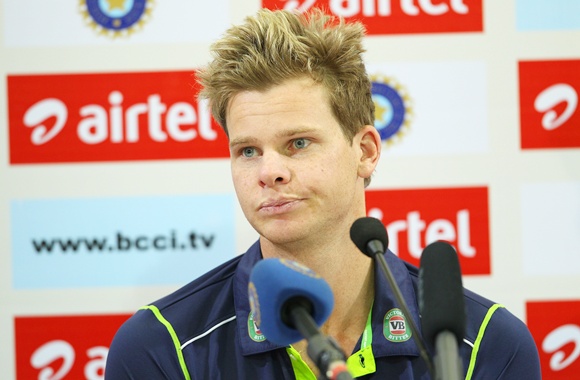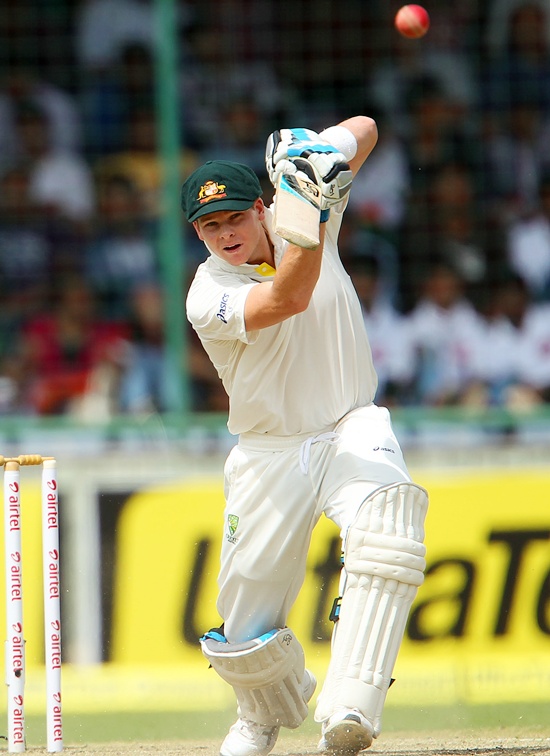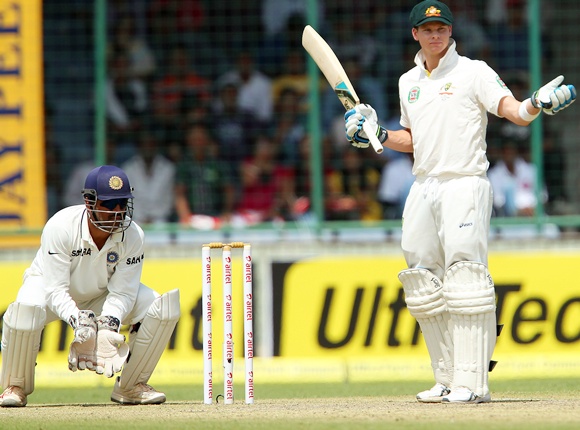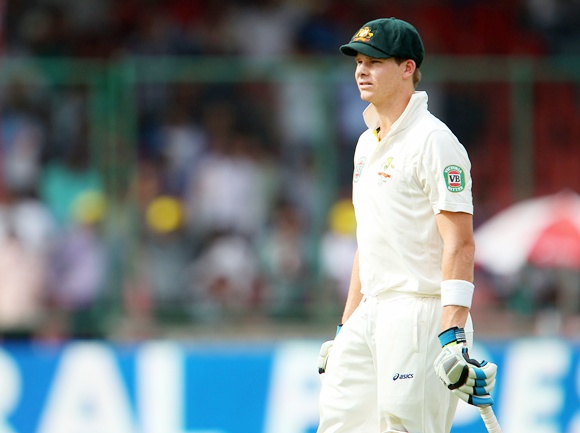 | « Back to article | Print this article |
It's getting tougher and tougher to bat: Smith
It is not unusual for an Indian pitch to start turning from Day 1, but the crack-filled track at the Feroz Shah Kotla is already showing ominous signs. Already questions are being asked whether the fourth Test against Australia will last the full five days.
-Tail rescues Australia after Indian spinners strike
-PHOTOS: India v Australia, Delhi Test, Day 1
Steven Smith missed out on a half-century, but spent the most time among all the Australian batsmen on the pitch, on day one of the final Test in Delhi, on Friday. Having had a good look at it, he feels the wicket will get more difficult to bat on as the match progresses, and even a score of around the 275-run mark would be a competitive total.
'This wicket has worn already'
"It's broken up a fair bit to start up with. It's going to get tougher and tougher to bat throughout this match, and 231 at the end of the day is not a bad day; I don't think!
Hopefully, we can grind out another 50 or so tomorrow, and I think that will be quite competitive as a first-innings score on that wicket," said Smith, who had a good knock of 46.
- Kotla pitch a 'three-day' wicket?
"This wicket has worn already. There's quite a bit of inconsistent spin already and bounce. If we can grind out another 50 I think that would be a very good first innings score," he added.
Australia's batsmen were guilty of throwing their wickets away
However, in all fairness, Australia's batsmen were guilty of throwing their wickets away; the pitch had little or nothing to do in some of those dismissals.
They have to thank their lower order which showed some fight to take their total to 231 for eight, after R Ashwin's brilliant spell of four for 40 in 30 overs had left them staring at another embarrassing performance with the bat.
Smith said he worked hard in the nets to improve his batting against spin during the first two Tests when he was not part of the playing eleven.
'It was about finding a way to first of all survive and then score runs'
"I've had a lot of time in the nets during the first two Tests. For me it was about finding a way to first of all survive and then score runs. For me, it's about having fast feet, trying to get down the wicket and taking advantage of the fields they've set when I first come in as well.
"For me it's fast feet forward and back and watching the ball as hard as I can and trying to play with the spin as much as possible," he said.
'The key is to be patient'
Smith said the key is to be patient at the start, and just spend time at the wicket, something some of his team mates were unable to.
"With the new ball, the first couple of overs are the easier time to bat than when the spinners come on with the harder ball. I think that's probably the toughest period," he opined.
"And, then, as the ball gets softer, it gets a little bit easier and the more you give yourself a chance out there, the more balls you face, it just gets a little bit easier.
"I think that's one thing that we've got to take out of this tour, trying to find a way to get in, to face as many balls as you can, and then it does get easier. That's something we are going to take out of this tour," he added.
'No one in our dressing room ever thought of this game as a dead rubber'
The right-hander said Australia never for a moment treated this Test as a dead rubber, but a chance to learn and improve against spin.
- Steven Smith up for the challenge of India's spin
"Every Test you play for Australia you're trying to win; you're going out and trying to play your best cricket.
"No one in our dressing room ever thought of this game as a dead rubber. It was about another chance to play in Indian conditions and try and improve and get better and develop plans and strategies to be successful. Hopefully this is another chance for us to keep doing that, so that when we come back here again, we'll be able to play with a bit more freedom and have a plan in place," he said.





